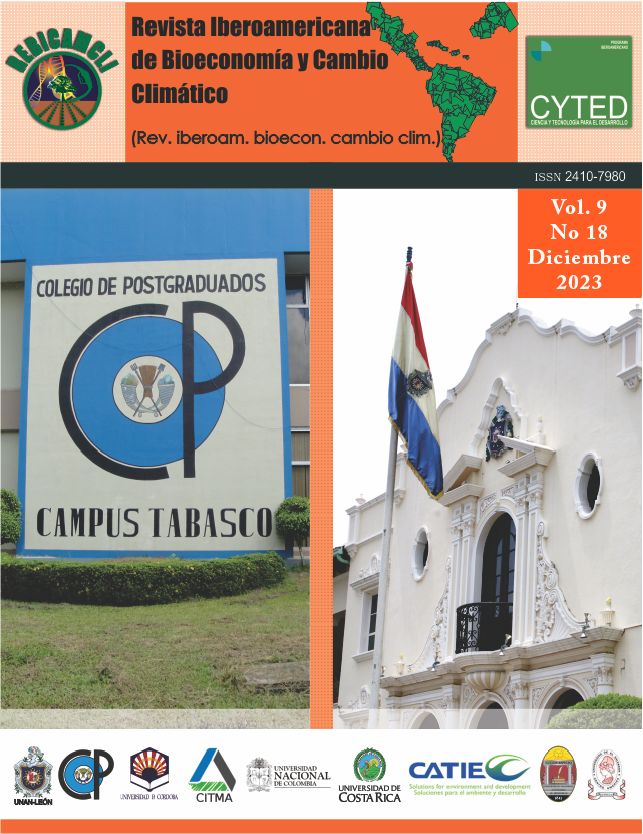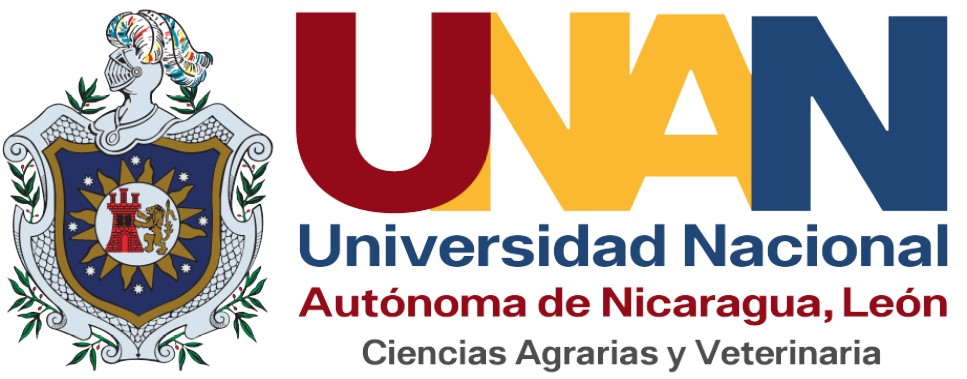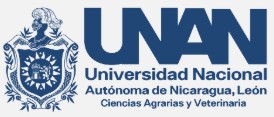Evaluation of mechanized tillage and amendments on the production of transvala grass (Digitaria decumbens Stent.) and its nutritional quality in San Mateo de Alajuela, Costa Rica
DOI:
https://doi.org/10.5377/ribcc.v9i18.18440Keywords:
Mechanized Tillage, Amendments, tillage, Rstudiio, dray matterAbstract
Abstract: Background: Digitaria decumbens Stent, used as cutting grass, represents an alternative feed for cattle. The objective of the research was to evaluate the effect of mechanized tillage and amendments on the production of
transvala grass and its nutritional quality. Methodology: The productive and nutritional variables of the grass were evaluated
78 and 173 days after the application of the treatments (DDAT); which consisted of Subsoiler, Mechanical Pallet, Decompactor, Subsoiler + Amendment, Mechanical Pallet + Amendment, Decompactor + Amendment and a Control.
Results: The treatments with amendment presented the highest values of coverage and height, both at 78 and 173 DDAT. However, at 78 days none of the treatments differed significantly from the Control. In the case of height, Mechanical Pallet + Amendment presented the highest value. After 173 days, the Mechanical Paling + Amendment and Subsoiler + Amendment treatments showed the highest height
with 39.91 and 39.25 cm respectively. The coverage on this same date was higher in the Mechanical Paling + Amendment and Subsoiler + Amendment treatments with a median of 96 and 95 % respectively, being significantly different from the Control. The Subsoiler + Amendment treatment presented the highest production (423.06 ± 32.51 bales/ha) at 78 DDAT. After 173 days, the Mechanical Paling + Amendment obtained the highest values (268.97 ± 26.57 bales/ha). Conclusions: The tillage treatments together with the application of lime and compost significantly increased grass production, even reaching double the production, however, the nutritional quality of the grass is not altered by the treatments applied in this study.
Downloads
Metrics
References
Alvarado, A., Mata, R., & Chinchilla, M. (2014). Arcillas identificadas en suelos de Costa Rica a nivel generalizado durante el período 1931-2014: II. Mineralogía de arcillas en suelos con características vérticas y oxídico caoliníticas. Agronomía Costarricense, 38(1), 107-131.
Angulo-Arroyave, R., & Rosero-Noguera, R. (2018). Producción de forraje y calidad nutricional del pasto angleton climacuna (Dichanthium annulatum-Forssk-Stapf) para la producción de heno en La Dorada (Caldas). Revista de Producción Animal, 30(2), 12-17.
Association of Official Analytical Chemist (AOAC). (1991). Methods of analysis. Washington D.C., USA: AOAC, Inc.
Baker, C. J., Saxton, K. E., Ritchie, W. R., Chamen, W. C., Reicosky, D. C., Ribeiro, M. F., Hobbs, P. R. (2008). Siembra con labranza cero en la agricultura de conservación. Zaragoza-España: FAO-ACRIBIA, S.A.
Biazatti, R. M., Bergamin, A. C., Ferreira, W. S., Ferreira, E., Souza, F. R. de, Almeida, P. M. de, & Dias, J. R. M. (2020). Fitomassa do Capim-Braquiária e atributos químicos de um latossolo sob compactação induzida e doses de calcário / Phytomass of Brachiaria and chemical attributes of a latossil under induced compaction and doses of limestone. Brazilian Journal of Development, 6(8), Art. 8.
https://doi.org/10.34117/bjdv6n8-093
Bol, R. (2010). Challenges and Opportunities for Carbon Sequestration in Grassland System - A Technical Report on Grassland Management and Climate Change Mitigation. The Journal of Agricultural Science, 148(6), 735-736.
https://doi.org/10.1017/S0021859610000468
Camacho, M. E., Mata, R., Forsythe, W., Camacho, M. E., Mata, R., & Forsythe, W. (2015). Labranza mecanizada de pasturas mediante tres implementos en un ultisol y sus implicaciones físicas e hidropedológicas. Agronomía Costarricense, 39, 101-115. https://doi.org/10.15517/rac.v39i3.21812
Capstaff, N. M., & Miller, A. J. (2018). Improving the Yield and Nutritional Quality of Forage Crops. Frontiers in Plant Science, 9, 535. https://doi.org/10.3389/fpls.2018.00535
Dawson, L. A., Thornton, B., Pratt, S. M., & Paterson, E. (2004). Morphological and topological responses of roots to defoliation and nitrogen supply in Lolium perenne and Festuca ovina. New Phytologist, 161(3), 811-818.
https://doi.org/10.1111/j.1469-8137.2004.00979.x
Demuner-Molina, G., Cadena-Zapata, M., Campos-Magaña, S. G., Zermeño-González, A., & Sánchez-Pérez, F. de J. (2014). Efecto de labranza y mejoradores de suelo en humedad y desarrollo radicular. Tecnología y ciencias del agua, 5(2), 123-130.
dos Santos, D. R., Tiecher, T., Gonzatto, R., Santanna, M. A., Brunetto, G., & da Silva, L. S. (2018). Long-term effect of surface and incorporated liming in the conversion of natural grassland to no-till system for grain production in a highly acidic sandy-loam Ultisol from South Brazilian Campos. Soil and Tillage Research, 180, 222-231.
https://doi.org/10.1016/j.still.2018.03.014
Estrada Alvarez, J. (2002). Pastos y forrajes para el trópico colombiano. Editorial Universidad de Caldas. https://scholar.google.com/scholar_lookup?title=Pastos+y+forrajes+para+el+tro%CC%81pico+colombiano&author=Estrada+Alvarez%2C+Julia%CC%81n.&publication_year=2002
Freeman, K. W., Girma, K., Arnall, D. B., Mullen, R. W., Martin, K. L., Teal, R. K., & Raun, W. R. (2007). By-Plant Prediction of Corn Forage Biomass and Nitrogen Uptake at Various Growth Stages Using Remote Sensing and Plant Height. Agronomy Journal, 99(2), 530-536.
https://doi.org/10.2134/agronj2006.0135
García, R. (2015). Efecto de sistemas de labranza en propiedades físicas del suelo y desarrollo radicular del cultivo de quinua (Chenopodium quinoa W.). Revista del Instituto de investigación de la Facultad de minas, metalurgia y ciencias geográficas, 18(35), Art. 35.
Islam, M. R., Jahan, R., Uddin, S., Harine, I. J., Hoque, M. A., Hassan, S., Hassan, M. M., & Hossain, M. A. (2021). Lime and Organic Manure Amendment Enhances Crop Productivity of Wheat-Mungbean-T. Aman Cropping Pattern in Acidic Piedmont Soils. Agronomy, 11(8), Art. 8.
https://doi.org/10.3390/agronomy11081595
Kamprath, E. J. (1984). Crop response to lime on soils in the tropics. Soil acidity and liming, 12, 349-368.
https://doi.org/10.2134/agronmonogr12.2ed.c9
Kendall, C., Leonardi, C., Hoffman, P. C., & Combs, D. K. (2009). Intake and milk production of cows fed diets that differed in dietary neutral detergent fiber and neutral detergent fiber digestibility. Journal of Dairy Science, 92(1), 313-323.
https://doi.org/10.3168/jds.2008-1482
Lara Mantilla, C., Oviedo Zumaqué, L. E., & Betancur Hurtado, C. A. (2010). Efecto de la época de corte sobre la composición química y degradabilidad ruminal del pasto Dichanthium aristatum (Angleton). Zootecnia Tropical, 28(2), 275-282.
Li, Y., Cui, S., Chang, S. X., & Zhang, Q. (2019). Liming effects on soil pH and crop yield depend on lime material type, application method and rate, and crop species: A global meta-analysis. Journal of Soils and Sediments, 19(3), 1393-1406.
https://doi.org/10.1007/s11368-018-2120-2
Medina M., C. (2016). Effects of soil compaction by trampling of animals in soil productivity. Remediations. Revista Colombiana de Ciencia Animal - RECIA, 88. https://doi.org/10.24188/recia.v8.n1.2016.229
Miller, B. J. (1983). Chapter 8 Ultisols. In Developments in Soil Science 11, 283-323. Elsevier.
https://doi.org/10.1016/S0166-2481(08)70619-6
Montanari, R., Lima, E. de S., Lovera, L. H., Godoy, L. T. R., Henrique, A. F., & Dalchiavon, F. C. (2013). Correlación de la productividad de un forraje con las propiedades físicas de un Ultisol en Aquidauana. Revista Ceres, 60, 102-110.
https://doi.org/10.1590/S0034-737X2013000100015
Morales, E. B., Sánchez, J. B., León, R., Aguas, S. B., & Mohiddin, J. (2018). Evaluación del pasto miel (Setaria sphacelata) por efecto de la fertilización y enmienda química, en noroccidente, Pichincha-Ecuador. Ciencia, 20(2), Art. 2.
https://doi.org/10.24133/ciencia.v20i2.1210
Morales J, Acuña V, Cruz A. (2006). Efecto de la fertilización nitrogenada sobre la producción y valor nutritivo del pasto transvala (Digitaria decumbens cv. Transvala) para henificación, bajo condiciones de riego. Alcances tecnológicos, 4(1),45-51. https://doi.org/10.35486/at.v4i1.114
Núñez, A. (2013). Métodos de investigación científica y técnica aplicada a ingeniería de telecomunicación (notas de curso) Tema 3:, Diseño de experimentos Diseño de bloques al azar. Instituto Universitario de Microelectrónica Aplicada, Universidad de Las Palmas de Gran Canaria, España.
Olego, M. Á., Quiroga, M. J., Mendaña-Cuervo, C., Cara-Jiménez, J., López, R., & Garzón-Jimeno, E. (2021). Long-Term Effects of Calcium-Based Liming Materials on Soil Fertility Sustainability and Rye Production as Soil Quality Indicators on a Typic Palexerult. Processes, 9(7), Art. 7. https://doi.org/10.3390/pr9071181
Osuna-Ceja, E. S., Figueroa-Sandoval, B., Oleschko, K., Flores-Delgadillo, M. de L., Martínez-Menes, M. R., González-Cossío, F. V., Osuna-Ceja, E. S., Figueroa-Sandoval, B., Oleschko, K., Flores-Delgadillo, M. de L., Martínez-Menes, M. R., & González-Cossío, F. V. (2006). Efecto de la estructura del suelo sobre el desarrollo radical del maíz con dos sistemas de labranza. Agrociencia, 40(1), 27-38.
Piedra Quesada, V. (2017). División territorial administrativa de la República de Costa. San José: Imprenta Nacional.
Poppi, D. P., & McLennan, S. R. (1995). Protein and energy utilization by ruminants at pasture. Journal of Animal Science, 73(1), 278-290. https://doi.org/10.2527/1995.731278x
Ramírez Pedroso, J. F., González Cañizares, P. J., Rivera Espinosa, R., Hernández Jiménez, A., Ramírez Pedroso, J. F., González Cañizares, P. J., Rivera Espinosa, R., & Hernández Jiménez, A. (2021). Respuesta al encalado de pastos del género Urochloa, cultivados en la región Sabana de Manacas, Cuba. Cuban Journal of Agricultural Science, 55(2).
Ramírez, R. G., González-Rodríguez, H., García-Dessommes, G., & Morales-Rodríguez, R. (2005). Seasonal Trends in Chemical Composition and Digestion of Dichanthium annulatum (Forssk.) Stapf. Journal of Applied Animal Research, 28(1), 35-40.
https://doi.org/10.1080/09712119.2005.9706784
Roncallo, B., Sierra, A. M., & Castro, E. (2012). Rendimiento de forraje de gramíneas de corte y efecto sobre calidad composicional y producción de leche en el Caribe seco. Ciencia y Tecnología Agropecuaria, 13(1), Art. 1.
https://doi.org/10.21930/rcta.vol13_num1_art:242
Roque Garcia. (2015). Efecto de sistemas de labranza en propiedades físicas del suelo y desarrollo radicular del cultivo de quinua (Chenopodium quinoa W.). Rev. del Instituto de Investigación (RIIGEO), FIGMMG-UNMSM, 18(35), 109-113.
Santos, M., de Oliveira Castro, Y., Marques, R., Débora, R., Godoy, M., & Patrícia, N. (2016). Importância da calagem, adubações tradicionais e alternativas na produção de plantas forrageiras: Revisão. Pubvet, 10, 1-12.
https://doi.org/10.22256/pubvet.v10n1.1-12
Serrano, J., Shahidian, S., Marques Da Silva, J., Sales-Baptista, E., Ferraz De Oliveira, I., Lopes De Castro, J., Pereira, A., Cancela De Abreu, M., Machado, E., & Carvalho, M. de. (2018). Tree influence on soil and pasture: Contribution of proximal sensing to pasture productivity and quality estimation in montado ecosystems. International Journal of Remote Sensing, 39(14), 4801-4829. https://doi.org/10.1080/01431161.2017.1404166
Solano, J. & Villalobos, R. (2012). Regiones y Subregiones Climáticas de Costa Rica. San José: Instituto Meteorológico Nacional
Tecnológicos, A. (2019). La Industrialización del heno de alta calidad en Costa Rica. Alcances Tecnológicos, 4(1), 2.
https://doi.org/10.35486/at.v4i1.107
Villamar Moreira, J. P. (2022). Efectos del biol bovino en rendimientos de biomasa verde y valores nutricionales del pasto saboya (Megathyrsus maximus) [BachelorThesis, Calceta: ESPAM MFL]. http://repositorio.espam.edu.ec/handle/42000/1881
West, L. T., Beinroth, F. H., Sumner, M. E., & Kang, B. T. (1997). Ultisols: Characteristics and Impacts on Society. En D. L. Sparks (Ed.), Advances in Agronomy, 63, 179-236. https://doi.org/10.1016/S0065-2113(08)60244-8
Zhang, J., Bei, S., Li, B., Zhang, J., Christie, P., & Li, X. (2019). Organic fertilizer, but not heavy liming, enhances banana biomass, increases soil organic carbon and modifies soil microbiota. Applied Soil Ecology, 136, 67-79. https://doi.org/10.1016/j.apsoil.2018.12.017
Downloads
Published
How to Cite
Issue
Section
Categories
License
Copyright (c) 2023 Iberoamerican journal of bioeconomy and climate change

This work is licensed under a Creative Commons Attribution-NonCommercial-ShareAlike 4.0 International License.
Copyright © 2025 Rev. iberoam. bioecon. climate change. National Autonomous University of Nicaragua León (UNAN-León), Knowledge Area of Agrarian and Veterinary Sciences / Specific Area of Agroecology and Agribusiness / Center for Research in Agrarian Sciencies. Academic Directorate. Research Department. Publication and scientific events Unit.












 EDITORIAL
EDITORIAL e-ISSN
e-ISSN


 COPYRIGHT
COPYRIGHT This work is licensed under a Licencia Internacional
This work is licensed under a Licencia Internacional 












